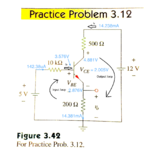huub8
Junior Member level 3
I'm trying to solve a practice problem, but I can't seem to get the calculation right.
I'm suppossed to calculate Vo and Vce
the current gain is 100, and the Vbe is 0.7 V
The answer is: 2.876 V and 1.984 V

I can only think of this:
KVL for the input loop gives:
-5 + 10 000 * Ib + 0.7 - 200 * (Ib - Ic) = 0
KVL for the output loop gives:
12 - 200 * (Ic - Ib) - Vce - 500 * Ic = 0
Ic = 100 Ib
But this gives me a wrong answer, what am I doing wrong?
I'm suppossed to calculate Vo and Vce
the current gain is 100, and the Vbe is 0.7 V
The answer is: 2.876 V and 1.984 V

I can only think of this:
KVL for the input loop gives:
-5 + 10 000 * Ib + 0.7 - 200 * (Ib - Ic) = 0
KVL for the output loop gives:
12 - 200 * (Ic - Ib) - Vce - 500 * Ic = 0
Ic = 100 Ib
But this gives me a wrong answer, what am I doing wrong?




